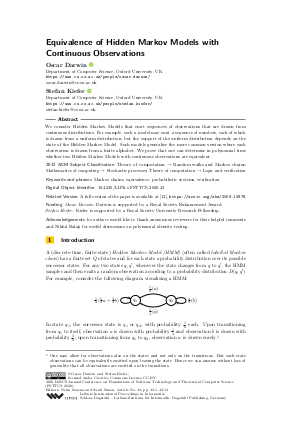@InProceedings{darwin_et_al:LIPIcs.FSTTCS.2020.43,
author = {Darwin, Oscar and Kiefer, Stefan},
title = {{Equivalence of Hidden Markov Models with Continuous Observations}},
booktitle = {40th IARCS Annual Conference on Foundations of Software Technology and Theoretical Computer Science (FSTTCS 2020)},
pages = {43:1--43:14},
series = {Leibniz International Proceedings in Informatics (LIPIcs)},
ISBN = {978-3-95977-174-0},
ISSN = {1868-8969},
year = {2020},
volume = {182},
editor = {Saxena, Nitin and Simon, Sunil},
publisher = {Schloss Dagstuhl -- Leibniz-Zentrum f{\"u}r Informatik},
address = {Dagstuhl, Germany},
URL = {https://drops.dagstuhl.de/entities/document/10.4230/LIPIcs.FSTTCS.2020.43},
URN = {urn:nbn:de:0030-drops-132845},
doi = {10.4230/LIPIcs.FSTTCS.2020.43},
annote = {Keywords: Markov chains, equivalence, probabilistic systems, verification}
}

 Creative Commons Attribution 3.0 Unported license
Creative Commons Attribution 3.0 Unported license























